- Author Matthew Elmers [email protected].
- Public 2023-12-16 21:49.
- Last modified 2025-01-24 09:17.
As you know, the most ancient daggers were made of stone. These could be flint or obsidian points with a barely outlined handle, which could, if desired, be used as a spearhead. In Denmark, a knife was found already with a clearly outlined handle, and one of the later samples, found in Sweden, generally imitates a bronze dagger and dates from about 1600 BC.
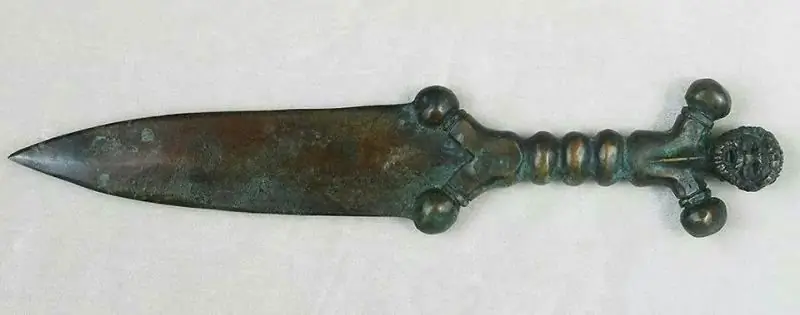
Celtic dagger made of bronze. Around 1200 BC The blade is cast in one piece with the handle, the latter having an anthropomorphic shape. Similar handles are known for both daggers and swords, but what exactly this shape is associated with is unknown. Metropolitan Museum of Art, New York.

Celtic sword in bronze. Metropolitan Museum of Art, New York.
However, why be surprised? In the Mexico City Museum, you can see ritual knives for human sacrifice made of obsidian, trimmed with turquoise and gold. Probably a golden dagger could be made. After all, they were made by the Egyptians, but … they left obsidian, it is sharper. The emperor Heliogabalus in Rome, however, ordered himself golden swords to cut himself in the event of an attempt, but did not have time to use them.
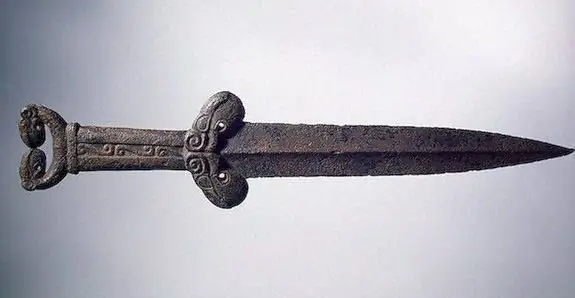
Dagger of Tagar culture, V century. BC. The dagger manufacturing technology is noteworthy. The blade is iron, but the handle is cast in bronze in the famous "animal style". State Hermitage, St. Petersburg.
And here it is important to note one curious fact: cold weapons with a short blade over time began to be decorated much more abundantly than a long-bladed one. Of course, we can find richly decorated Turkish and Indian sabers, and Japanese swords, yes, of course, but there are many more ornate daggers. Why this is so - is understandable! The more often we use, then they decorate. In the novel by A. P. Chapygin "Razin Stepan" the tsarist detectives conspire to capture Stepan at the entrance, that is, in the outhouse. "He won't climb so much with a saber!" - notices the clerk giving them instructions, that is, it was inconvenient to walk with a saber all the time, you had to take it off, which was also inconvenient. But since the times were then harsh, and people needed weapons all the time, they took it as a fashion to carry daggers with them, which they began to richly decorate, in order, in addition to everything, to emphasize their social status.

Turkish dagger of the 18th century with a slotted blade. Length 33.8 cm; weight 258 g. Metropolitan Museum of Art, New York.

For comparison - an Indian dagger also with a slotted blade of the 18th century. Jade, gold, rubies, emeralds are used in the decoration. Length 43, 18 cm. Metropolitan Museum of Art, New York.
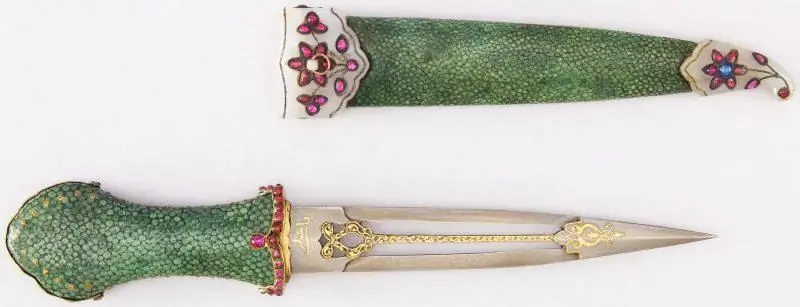
And one more dagger and a blade with a slot - also India and also in the 18th century. Shark skin, gold, rubies, emeralds, sapphires, silver. Blade length 16.5 cm. Metropolitan Museum of Art, New York.
At the same time, in different countries, different forms of blades and methods of finishing the handles and scabbards have been developed. And if earlier the same Romans looked at weapons as a very functional object and nothing more, then over time it also turned into an object of art, a means of capitalization and … PR. We read the novel by R. Kipling "Kim": "Sahib gave me a gourde saber, and it turned red from the blood of my brother" - says one of the local characters. That is, an expensive gift was made to him by an English Sahib, well, after all, it was worth it - to fight with someone else's hands for a beautiful tsatsuk - this is the most correct method, however. That is, if a person is stupid, then why not take advantage of this? By the way, this is where the custom of donating weapons comes from: it was given by kings, kings, emperors, shahs and padishahs, but now it is given by presidents and presidents, and, like in the old days, they do not regret gold.
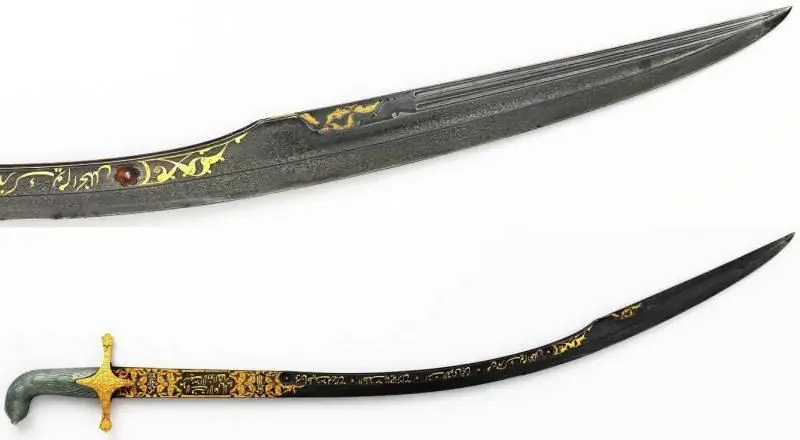
Turkish saber kilich XVIII century. Damascus steel, gold. Length 96.5 cm; blade length 83.2 cm. Metropolitan Museum of Art, New York.
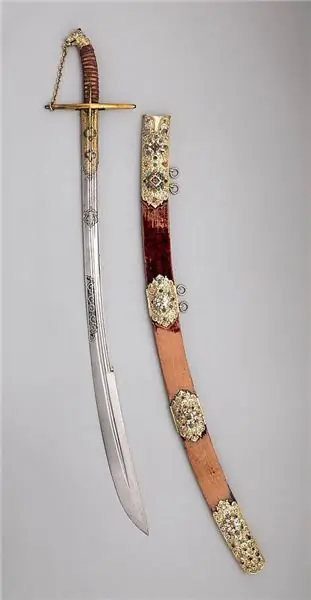
Polish shipbuilder's saber of the early 17th century. Compared to the Turkish one, of course, it looks rather poor. Metropolitan Museum of Art, New York.
What are the most decorated short bladed weapons? Judging by the museum exhibits, for example, the samples available in the Metropolitan Museum of Art in New York, Turkish and Indian samples can claim the title of the most richly decorated. Then comes Iran, and all the rest are just pale copies of what was created by the craftsmen there. The Kubachin weapons had excellent finishing, but … they were masterful, but still not so rich. Turkish craftsmen used not only gold and silver for decoration, but also gems, corals, pearls, shark skin - that is, the value of the decoration itself sometimes exceeded the cost of the blade itself many times over.
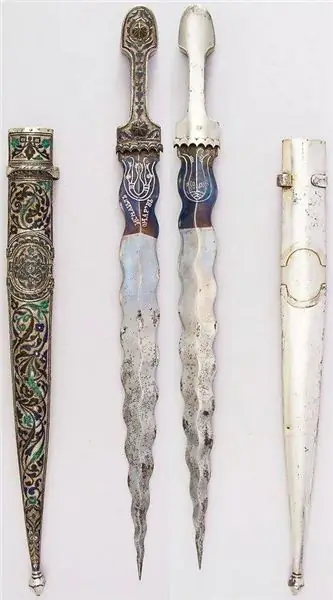
"My dagger shines with gold trim …" Who knows these lines by M. Yu. Lermontov? And here it is in front of you: the Caucasian dagger of the Kama of the 19th century. moreover, Dagestan work, as indicated by the elongated head of the handle. But what is his wavy blade? A very unusual weapon, and a blade of a completely uncharacteristic shape for the Caucasus. Steel, silver, enamel. Length 54.9 cm. Weight 354.4 g. Metropolitan Museum of Art, New York.
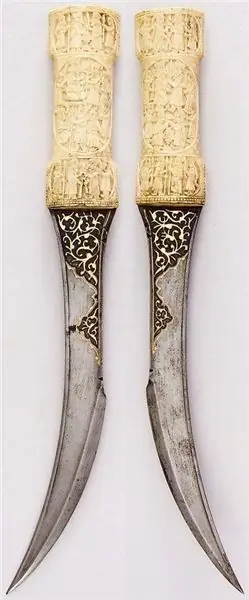
But the Persian jambiya of the 19th century. The blade is generally not half sharpened. Steel, gold, carved ivory. Length 43.8 cm. Weight 462.1 g. Metropolitan Museum of Art, New York.
At the same time, the gunsmiths tried to make the blades themselves structurally more beautiful and more deadly, for which they embarked on various tricks. Blades with slots were used, in fact, they did not play any role, with a wavy or serrated blade.
Sometimes this was justified, but only sometimes in some specific types of weapons, in particular, boarding. But for household weapons, the shape of the blade did not play any practical role. After all, a person can be stabbed with the most ordinary kitchen knife, and the stabbed one will be a little consolation to see a dagger sticking out of his chest with a jade handle and trimmed with gold and diamonds!
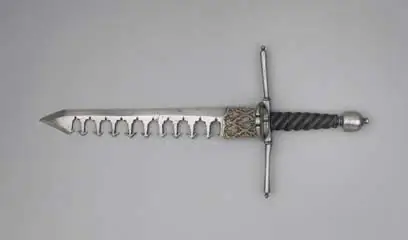
Blade dagger. How it was used in battle is very well shown in the Soviet film "Black Arrow", based on the novel of the same name by Stevenson. Metropolitan Museum of Art, New York.
But as a testament to the craftsmanship and skill of the master gunsmiths, the richly finished weapons are of course unmatched. It is a mastery, a fusion of technologies from many generations, the aesthetics of ancient views on the concept of "beauty", local traditions, attitude to religion and much, much more, which allows us to better understand the spiritual culture of other peoples!
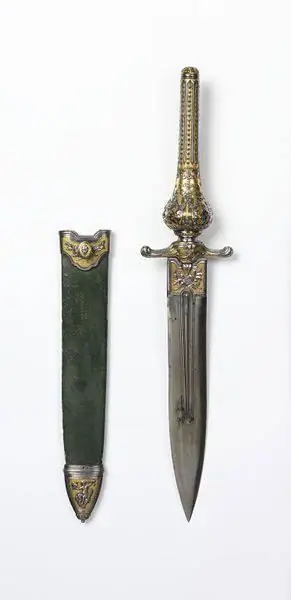
Bayonet-plug - Spanish bayonet of the 18th century. The same dagger inserted into the barrel of a musket. Victoria and Albert Museum, London.






